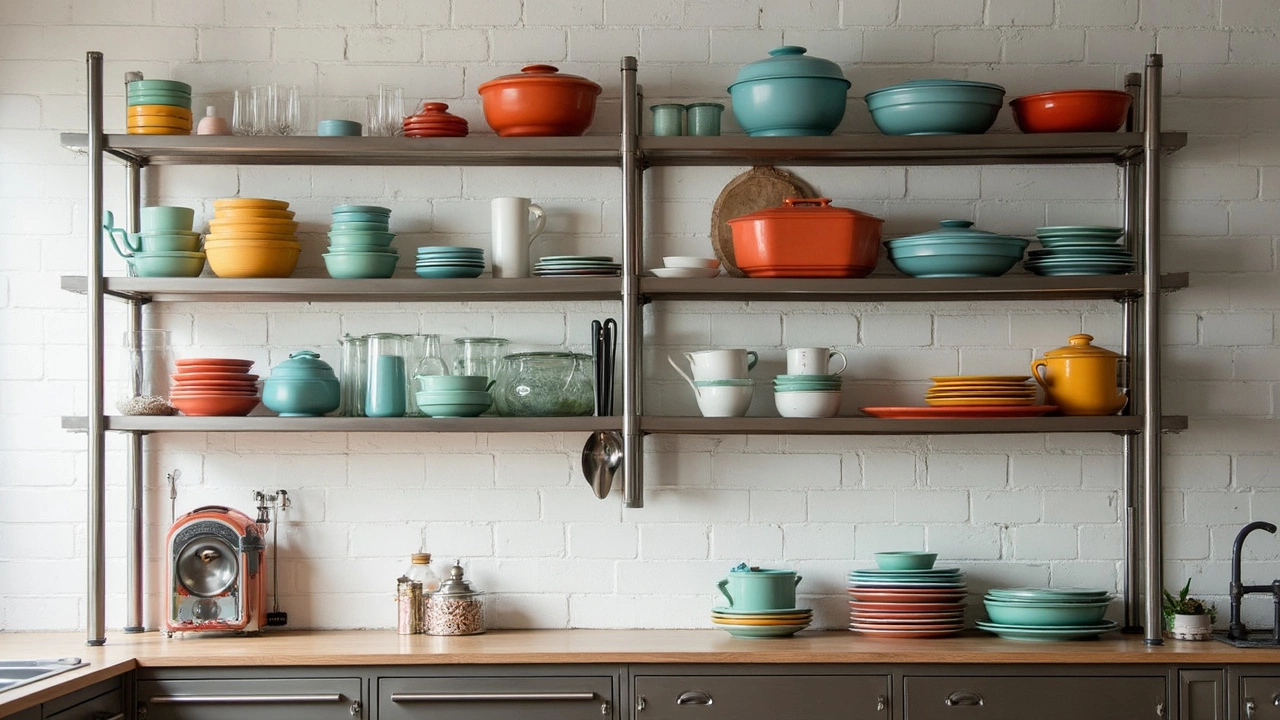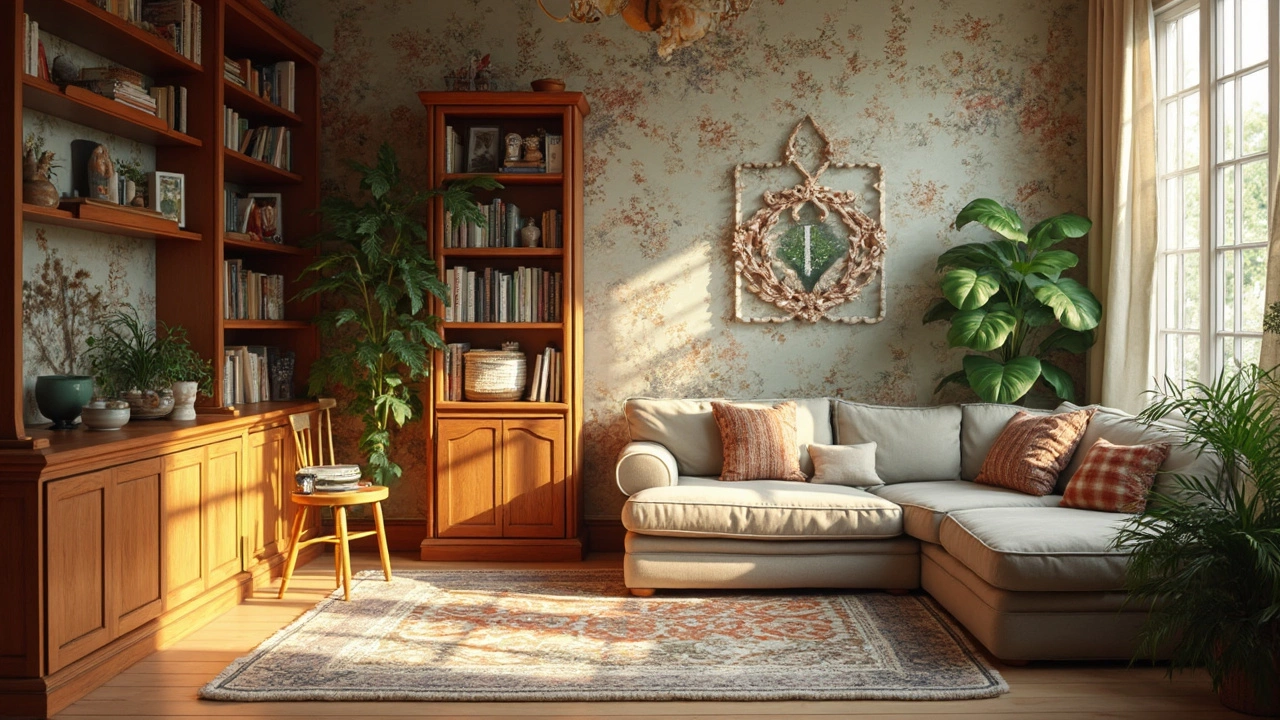When you're thinking about setting up shelves, picking the right material is a game changer. You want shelves that don't just sit there; they have to handle the weight of books, dishes, or whatever else you plan to put on them. Plus, they need to fit in with your décor without demanding an overhaul every year or so. No one wants sagging shelves as a feature, right?
Wood has been a favorite for ages, not just because of its classic good looks. It's strong and blends well with virtually any style, from rustic to modern. Pine and oak are popular choices, offering durability and a homely feel. On the other hand, metal, like steel or aluminum, offers a fresh and modern vibe. It's perfect when you want an industrial or sleek look, plus it's incredibly durable and often cheaper than high-quality woods.
- Understanding Different Materials
- Wood: Classic Appeal Meets Function
- Metal: Modern and Durable
- Practical Tips for Stronger Shelves
Understanding Different Materials
Choosing the right material for your shelving isn't just about looks. It’s about finding something that can handle what you're throwing on it—literally. Let’s break down the most common options and their pros and cons so you can make an informed choice.
Wood
Wood is a go-to choice for lots of folks. It’s not just versatile but it also has a natural charm that fits almost any room. Wood like pine and oak is sturdy and can support a good amount of weight. However, remember that solid wood shelves might come with a higher price tag and they may need a bit of upkeep to keep looking nice.
Metal
Now, if durability and modern style are more your thing, metal shelving might be your answer. Materials like steel and aluminum are super strong and can carry heavy loads without flinching. Metal shelves are also great in garages or workshops because they can take a beating and still look fresh.
Glass
Glass isn’t as widespread for everyday shelving because of its fragile nature, but it can sure add a touch of elegance, especially in living rooms or bathrooms. It’s a perfect choice for displaying lighter items, like photos or knick-knacks.
Plastic
For something low-cost and water-resistant, plastic shelves are worth considering. They’re lightweight and easy to move, and they work well in places like children’s rooms and bathrooms where things might get a bit messy.
| Material | Strength | Cost | Best Use |
|---|---|---|---|
| Wood | High | Medium-High | Living areas |
| Metal | Very High | Medium | Garages, offices |
| Glass | Medium-Low | High | Decorative spaces |
| Plastic | Low | Low | Kids’ rooms |
By the end of the day, weighing these options will help you pick the best shelving solution for your needs. Think about your budget, what you’re storing, and where these shelves are going. That’s how you’ll get the most bang for your buck.
Wood: Classic Appeal Meets Function
There's a reason why wood is the go-to when it comes to shelving. It’s not just about the aesthetics, though the warm, inviting appeal can't be ignored. Wood is versatile, strong, and pretty easy to work with, making it a no-brainer for many homeowners.
Pine vs. Oak: What’s the Difference?
Pine is your budget-friendly option. It's softwood, so it's lighter, which is great if you're mounting shelves yourself. Plus, it's easy to stain or paint, meaning you can get creative with your look. But, keep in mind, it's not as hard or strong as oak. Weighty items might cause it to sag over time.
Oak, on the other hand, is hardwood. It's robust and can handle heavy loads much better, which is why you often see oak in those sturdy library shelves. Its grainy texture also brings a touch of elegance and sophistication to a space. It might cost more upfront, but it’s an investment in durability.
Benefits of Wood Shelving
- Customizable: You can cut, shape, and finish wood to match your exact specs or design dreams.
- Repairable: Unlike many materials, wood can be sanded, refinished, and repaired if damaged.
- Environmental Impact: When sourced sustainably, wood is environmentally friendly and biodegradable.
Interesting Fact
Did you know that roughly 40% of homeowners opt for wood when installing new shelves? This is possibly due to its balance of cost, versatility, and strength, making it the ideal choice for different areas within the home.
Whether you lean toward pine for its affordability and ease, or oak for its sturdiness and style, wood shelving materials bring both function and form to the table. Just remember, if you're planning to put heavy stuff on them, consider reinforcing with strong wall supports to prevent any sagging surprises later!

Metal: Modern and Durable
Opting for metal shelving is like choosing a reliable friend who won't let you down. Metals like steel and aluminum aren't just tough; they bring a cool, sleek look that's hard to beat, especially if you're into industrial or minimalist styles. But don't just take my word for it—let's dig into why they rock.
Strength and Longevity
Metal shelves are the go-to when you need something that can hold a lot of weight without buckling under pressure. Perfect for a garage or a workspace where tools, equipment, and other heavy stuff need storing. They typically have a higher weight capacity compared to wood, so you'll have peace of mind piling them up.
Ever heard of galvanized steel? It's a popular choice due to its rust-resistant qualities. This makes it super handy for places like basements or sheds where moisture levels can get tricky.
On the Lookout for Style
If you're worried that metal might look cold or too industrial for your taste, think again. Combining metal shelves with wood accents or other materials can drastically soften their appearance, fitting seamlessly into different rooms.
Here's a fun fact: According to a recent survey, over 60% of new home renovators are now incorporating metal shelving for a chic, modern look without compromising on durability.
| Material | Weight Capacity | Rust Resistance |
|---|---|---|
| Steel | Up to 800 lbs | High |
| Aluminum | Up to 600 lbs | Moderate |
Easy Installation and Maintenance
Good news—setting up metal shelves is often more straightforward than you'd think. Many come as easy-to-assemble kits with clear, no-nonsense instructions. And once they're up, they won't need much fussing over. If you spill something or they get dusty, a quick wipe down usually does the trick.
So, whether you need a heavy-duty storage solution or want to add a modern touch to your living space, metal shelving might just be your best bet. Plus, they usually cost less in the long run due to their robustness and low maintenance, giving you bang for your buck.
Practical Tips for Stronger Shelves
Getting your shelves to not just look good but also be rock-solid is doable with a few handy tricks. Whether you're eyeing up the use of shelving materials to ace your decor or just wanting them to hold up your stuff, you need some practical know-how.
Secure the Foundation
First off, always mount your shelves onto wall studs. Studs are like the real MVPs of wall support. You can use a stud finder to locate them; it's a smart move, especially when you’re hanging heavy-duty shelving.
Anchors and Brackets
If studs are out of reach, wall anchors are your next best bet. Get those that expand behind the wall for a better grip. For added support, especially with wooden shelves, strong metal brackets are essential. Ensure they're evenly spaced and not just there for show.
Bracing for Strength
Think of bracing as adding a backbone to your shelving. If you've got long stretches of shelves, add vertical backboards to keep them from sagging. For metal shelves, integrated bracing is often included, but every bit helps.
- Use L-brackets underneath for more stability.
- Properly align brackets to evenly distribute weight.
Be Mindful of Load Limits
Don't stuff more than your shelves can handle. Sure, you want to display all your favorite novels, but overloading will make shelves bow. Keep heavier items at the ends with lighter ones in the middle. Check the manufacturer's weight limits, so you don’t spin over into broken shelf territory.
Level It Up
Finally, make sure everything’s level. A bubble level tool can save you from that awkward tilt. When your shelf is on point, it not only performs better but also just looks nicer, giving peace of mind for years of sturdy usage.
| Material | Max Load (per shelf) |
|---|---|
| Wood | 50-100 kg |
| Metal | up to 150 kg |

